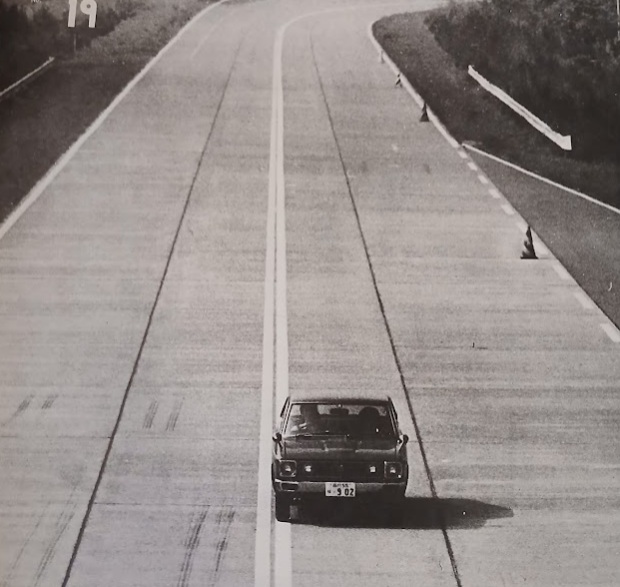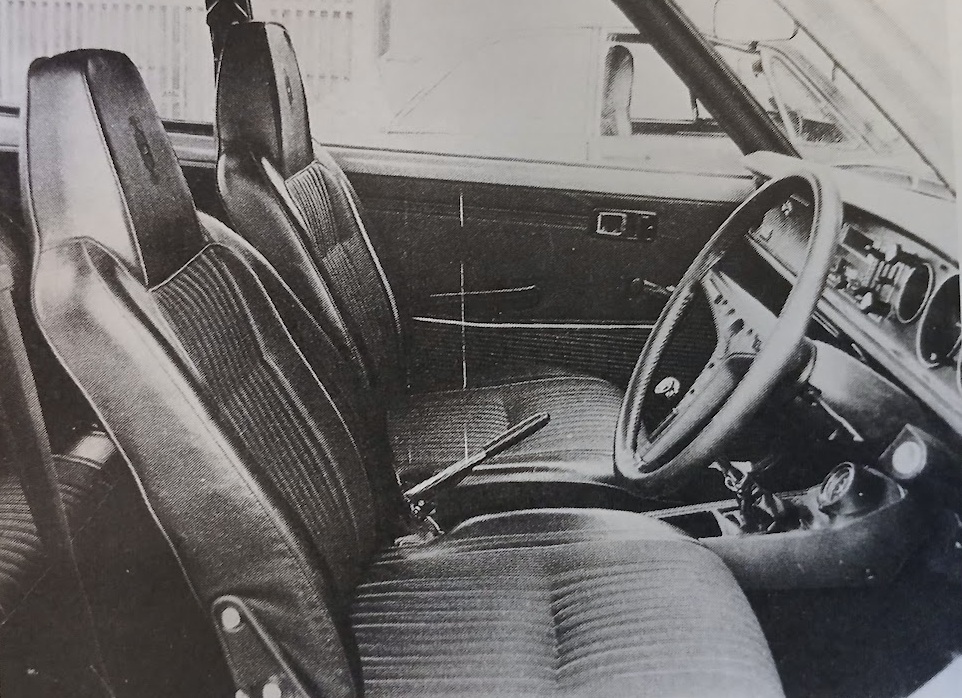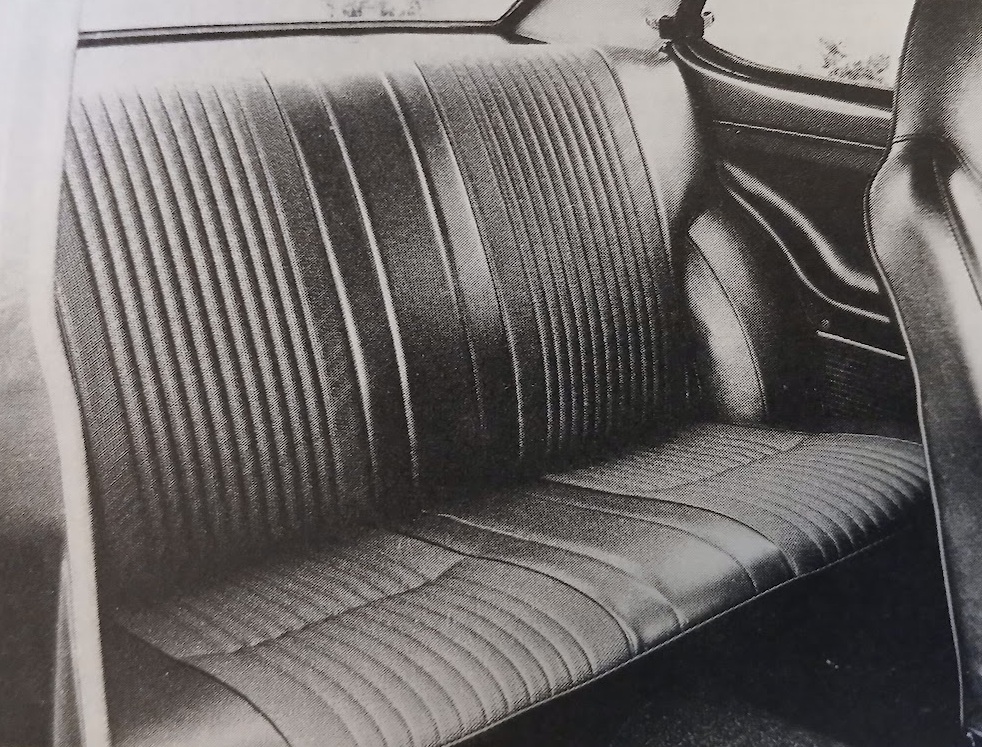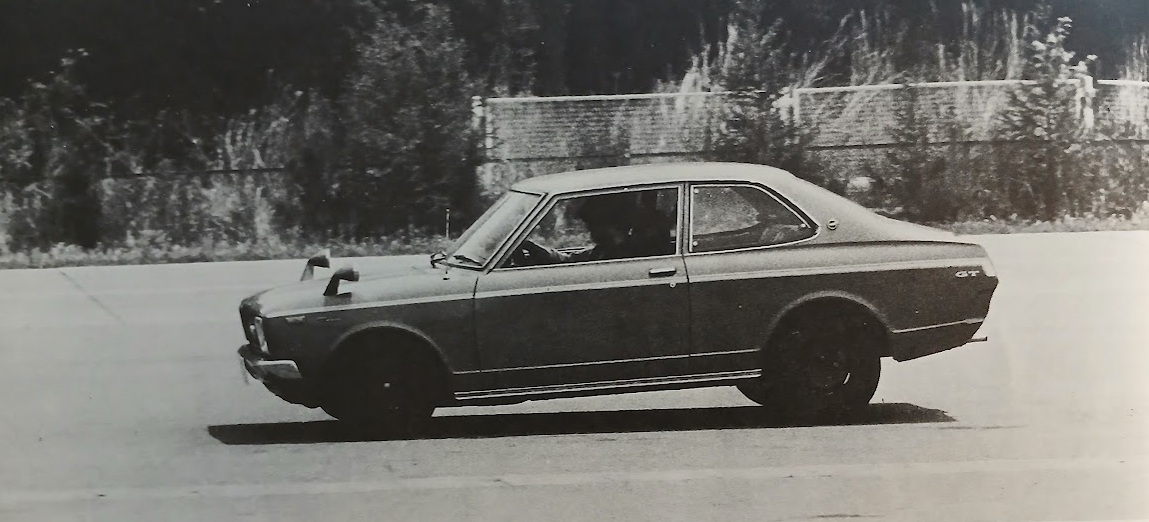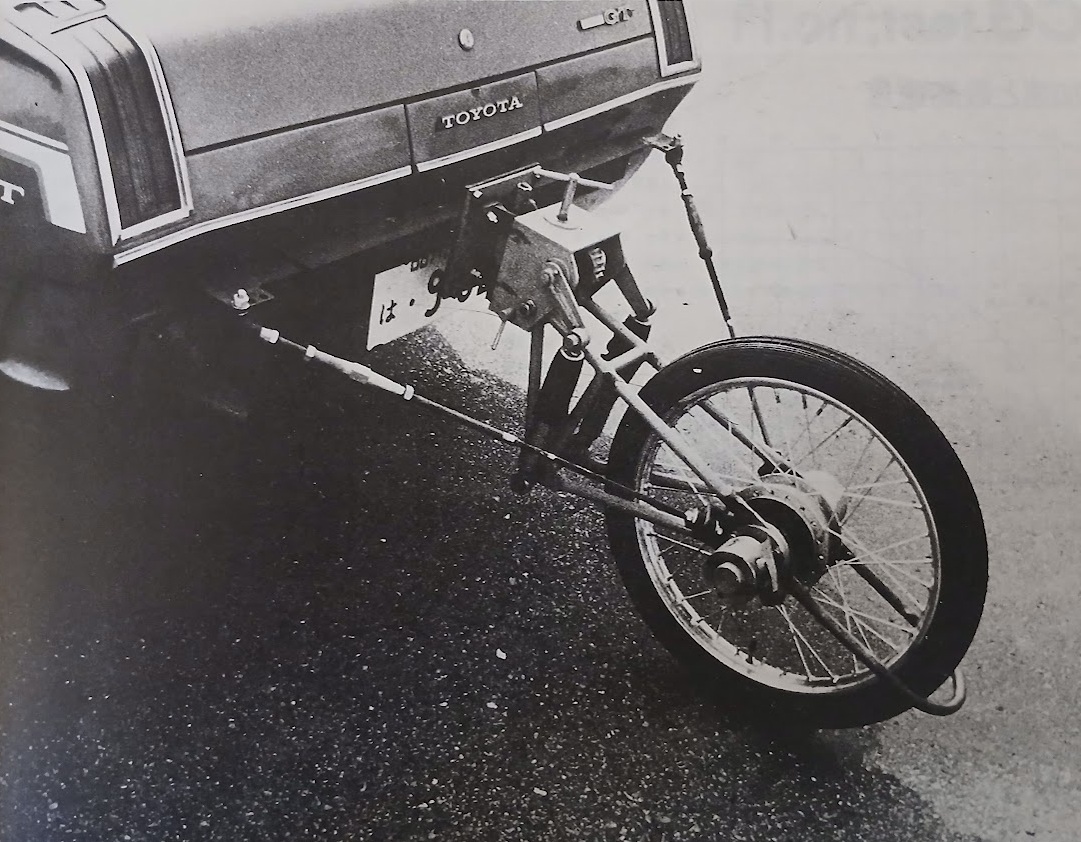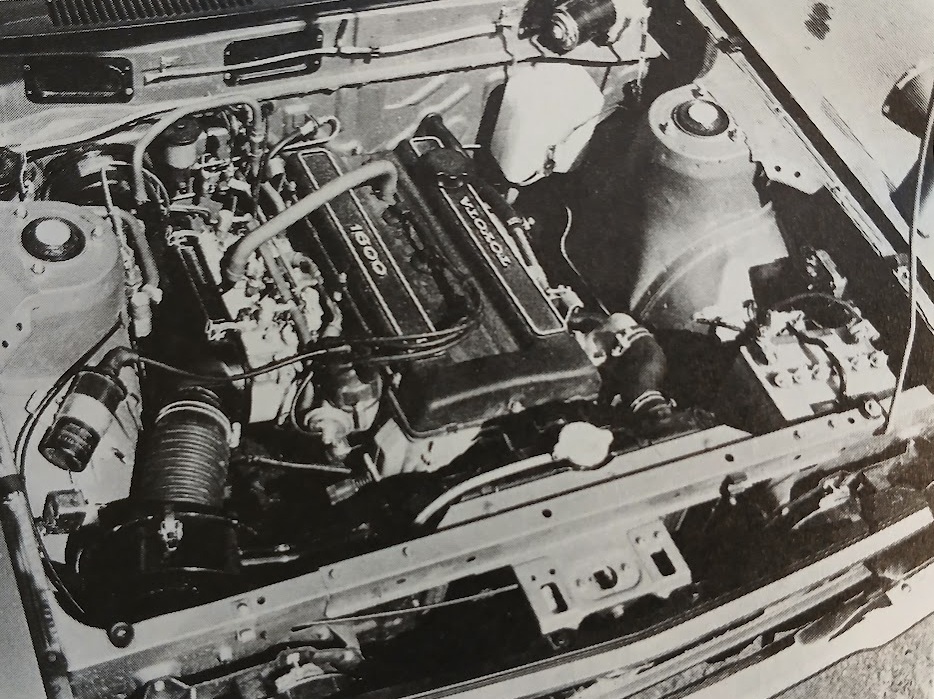Toyota Carina 1600GT (1971)
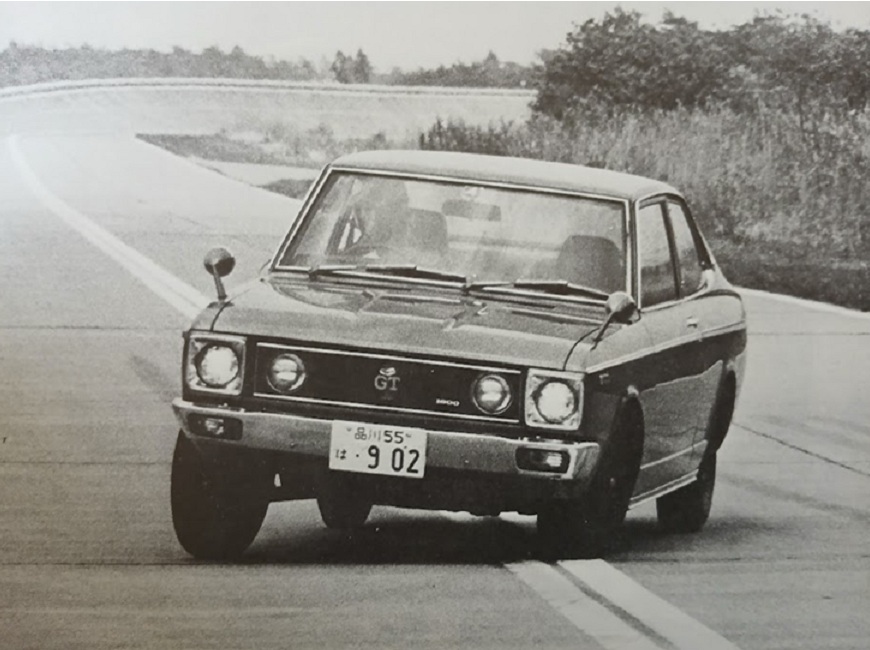
Publication: Car Graphic
Format: Road Test
Date: July 1971
Author: “C/G Test Group” (uncredited)
Summary:A family sports car with a 1.6-liter DOHC engine based on the two-door Carina ST. Excellent 5-speed gearbox. The engine is flexible enough to use fifth gear at 60km/h, making it suitable for low-speed driving in the city. High fade resistance from disc/drum brakes. High maneuverability on bias-ply tires. Balanced engine and chassis. Good comfort and interior equipment. Fuel economy is rather poor.
Road testing the Toyota Carina 1600GT
Toyota’s product planners are very quick to seize opportunities, and they always seem to be one step ahead of other companies in identifying market trends, especially in the field of sports cars. When the Celica and Carina were released, the C/G editorial department talked about how it would be nice to have a model that combined the DOHC 1.6-liter engine of the Celica GT with the body of the Carina sedan. It seems that such a desire was also prevalent among enthusiasts around the world, so Toyota produced a car with exactly those specifications. This was released on April 5th under the name Carina 1600GT, and is priced at 818,000 yen, between the previously most-expensive Carina 1600ST (OHV, 1588cc, 5-speed gearbox, 720,000 yen) and the Celica GT (875,000 yen).
The Carina 1600GT (TA12-MQ) uses the two-door sedan body of the Carina 1600ST, equipped with a DOHC 1558cc 115ps/6400rpm engine (2T-G type), a 5-speed gearbox, a rear axle with a 4.11 final drive ratio, and other components shared with the Celica GT. There is no four-door version (at least for now). The tires are the same as the Celica GT, with 4J x 13 rims and 6.45H-13-4PR low-profile tires as standard, with 165HR-13 radials as an option.
The Carina GT’s suspension has also been strengthened to handle the increased power. The spring constants are 1.9kg/mm front, 2.2kg/mm rear (compared to the ST’s 1.6kg/mm front, 1.7kg/mm rear), and the damping force is 90kg extension, 30kg compression front, and 105kg/42kg rear (compared to the ST’s 90kg/30kg front, 80kg/34kg rear). These settings are actually stiffer than those of the Celica GT (spring constants, 1.7kg/1.7kg, damping force, 90kg/30kg front, 80kg/40kg rear). The stabilizer has also been made thicker, from 21mm to 23mm.
The body is easily distinguished from other Carinas by the black-painted front grille and GT badges, and the thick tape stripe running down the side of the body. The windscreen, which was previously partially reinforced with 5mm thick glass, is now 6.3mm thick. The main difference in the interior is that it is unified in all-black, and the seats’ black knitted vinyl upholstery is the same as the Celica GT.
As a result of these modifications, the vehicle weight has increased by 35kg over the Carina ST (two-door, 910kg) to 945kg. This is mainly the result of the increased engine weight (140kg for the OHV 1.6-liter, 152kg for the DOHC 1.6-liter) and the strengthening of the drivetrain. The weight distribution has also changed slightly (from 56.6%/43.4% to 57.6%/42.4%), making the car even more nose-heavy.
There is a huge range of optional parts available for the Celica/Carina models, but one particularly important new item is the limited slip differential (available since May). We wanted to test a car equipped with this, but none was available, so the test car had the standard differential. The Carina GT comes in four body colors: red, metallic blue, gold, and green. Our test car was a vivid blue.
We tested the OHV Carina ST in the January 1971 issue of C/G, and highly praised its handling, which was comparable to that of the Alfa 1750 and Fiat 124S, along with the above-average power performance backed up by a 5-speed gearbox with good ratios. The performance of the 1600GT, which is 10ps more powerful, is even more impressive. The results of the top speed test at Yatabe were a 1km straight-line average of 175.4km/h and a 5.5km lap average of 173.1km/h. These results are close to the 176.km/h top speed of the Celica GT (C/G, April 1971), which is 5kg lighter (940kg) and uses the same engine in a more aerodynamic body with a smaller frontal area. Maximum speed was reached at 5500rpm in fifth gear, but the Celica GT reached its top speed at 5900rpm in fifth gear.
Since the gearing is the same for both cars, this difference in rotation speed can be considered to be the difference in effective tire radius. The Celica GT was equipped with 165HR-13 radial tires, while the Carina GT was equipped with Bridgestone’s new Super Speed 5 6.45H-13 bias-ply tires. As is well known, the increase in effective radius due to centrifugal force is minimal for radial tires, but with bias-ply tires, the radius can increase by nearly 8% at top speed. This was also supported by the fact that when the speedometer error was measured, it was quite inaccurate at low speeds, but as the speed increased, the error decreased, becoming zero at 160km/h. For a bias-ply tire, this tire has high tread rigidity and uniformity, which was proven by the small high-frequency vibrations from the suspension even when driving at top speed.
The tachometer is in the yellow zone from 6500 to 7000rpm, and in the red zone above that. The engine idles quietly at about 800rpm, and when you step on the gas, it responds immediately and briskly. In the lower gears, the revs wind up to 7000rpm effortlessly. The power is more than sufficient, and even in the direct-coupled fourth gear, it can reach up to 170km/h (6250rpm). It is extremely smooth throughout the entire range, and the DOHC valve gear noise is very low, but it is unfortunate that the exhaust system resonance increases around 3000 to 4000rpm when the power really comes in, making it a little harsh on the ears.
Top speeds have little practical meaning in the real world, especially on the roads of this country, and are merely interesting on paper. What really matters is performance at low and medium speeds up to 120km/h, and in this respect the Carina GT is even easier to drive than the ST. Even though the engine is a DOHC, the intake port has been narrowed down at the expense of performance at high speeds, and the duct has been made longer to utilize the inertia effect of the intake, so the torque does not drop even at low and medium speeds, and holds up very well. Therefore, just like the Alfa, the 5-speed gearbox allows you to freely use the top three gears according to your needs and mood, even at the relatively low speed of 100km/h. In other words, the gear ratios of the top three gears are close to each other, and the engine is very resilient, so the usable ranges of each gear overlap widely. For example, if you are not in a hurry, you can easily accelerate from 60 to 100km/h in overdrive fifth gear in 17.0 seconds, or you can drop down to fourth and it will take 12.8 seconds, or you can skip down to third gear and it will take just 8.2 seconds. The gear shift is light and precise, but the synchro is too slow. This test car, with a mileage of about 1,800km, exhibited some gear crunching during shifts.
Fifth gear can be engaged at 60km/h if you feel like it, and it has good response above 3000rpm. Although this may make you think that the gear ratios are short, this is not the case, as fourth gear is 26.3km/h at 1000rpm, and fifth gear is 30.6km/h. This is actually taller than the Alfa 1600 Super (fourth and fifth gears are 24.1km/h and 30.4km/h at 1000rpm, respectively). Moreover, the acceleration equals that of the Alfa, covering 0-400m in 17.0 seconds and 1-1000m in 32.1 seconds. This is almost comparable to the Celica GT that we tested earlier (16.8 seconds and 32.0 seconds).
The Carina GT has plenty of power, so it is extremely easy to drive on the highway as well as crowded city streets. First gear is only used when starting off (it is also easy to start in second gear). Second is effective for crawling at a slow speed, and fourth gear can be used from 40km/h. The clutch is light and the throttle is smooth, so driving in the city, which requires frequent gear shifts, is no hassle at all.
However, high performance does not come for free. Fuel economy can vary greatly depending on driving patterns, but no matter how you drive the Carina GT, it will not be economical. In our case, even when we drove from Tokyo to Yatabe at about 60km/h on National Route 6, which is relatively flat, we got 8.7km/l, and when we drove up the slope of Mt. Tsukuba, the average fuel consumption over 289km, including the Yatabe tests, was 6.6km/l. The average for the entire journey was only 7.0km/l. The test car used high-octane fuel, of course, but there is also a 110ps model (TA12-MQR with 2T-GR engine) with the compression ratio lowered from 9.8 to 8.8, allowing it to use regular fuel. The fuel tank holds 50 liters.
The handling is not particularly outstanding, but at least among the current Toyota models (all of which are ordinary designs with rigid rear axles), it is outstanding, and the chassis is well-balanced with the power of the 115ps engine. As mentioned in the suspension data listed earlier, the Carina has a stiffer suspension than the Celica GT, but in reality, the difference is not noticeable. We drove an ST right after the Carina was released, and felt that the springs were unusually stiff for a Toyota model, but that was apparently due to friction in the various parts due to the car’s newness. All the Celicas and Carinas we have driven since then have had a suitable ride on all road surfaces.
The first Carina ST we drove had very quick steering response due to the combination of the stiff springs and the Bridgestone Radial 10 tires, but the GT, equipped with bias-ply Bridgestone Super Speed 5 6.45H-13-4PR tires, felt more like an ordinary European car. The steering ratio is 18.1:1, with 3.5 turns from lock to lock, and a turning radius of 4.8m. Considering the size and weight of the car, the steering is quite sharp. Steering force is always moderate regardless of the speed.
Despite the nose-heavy 57.6%/42.4% weight distribution, the understeer is not too strong, and the car shows very good maneuverability. When cornering at high speed, the car enters with slight understeer and rolls quite a bit at the same time, but if you add more power in the appropriate gear, the tail slides very smoothly and you can take a clean exit line. The Bridgestone Super Speed 5 has high lateral stiffness for a bias-ply tire, similar to Dunlop’s Grand Speed 1, and has very good grip, at least on dry roads. The steering response is not as sharp as with radials, but there is almost no kickback in response to uneven road surfaces and the tires are quiet. As mentioned above, this tire can also withstand continuous high-speed driving, so overall, it can be said to be more suitable for general users than radials.
The ride is just right, not too hard at low speeds like the Alfa, and not tiring even on long rides in poorly paved areas of Tokyo. The only problem with the ride is that the unsprung masses in the suspension set up a resonating vibration at low speeds of about 40km/h on washboard gravel roads with high-frequency bumps. It would probably calm down if you went faster, but that’s dangerous on gravel roads where braking is ineffective, so you have no choice but to slow down. This is common in cars with MacPherson struts on the front wheels, and it is particularly noticeable in the Carina GT.
The braking power of the is sufficient for the high dynamic performance of the Carina GT. The front brakes are Bendix F-type discs with a 184mm diameter, the rears are 228mm leading-trailing drums, equipped with a vacuum servo with a servo ratio of 2.6 and a proportioning valve that maintains the appropriate distribution of braking power. The pedal pressure is moderate, and the braking effect is strong and stable from low to high speeds. In the 0-100-0 fade resistance test, where we accelerate to 100km/h and brake to an 0.5g stop ten times in a row, the Carina GT started with an initial pedal pressure of 18kg, which dropped to 16kg on the second and third stops (disc brakes perform best when the pads are properly warmed up), then increased slightly to only 20.5kg on the tenth stop. The behavior was smooth right to the end, so these brakes were deemed to have particularly excellent fade resistance. The handbrake, conveniently located next to the seat, has a screw for adjusting the wire play from inside the car, which is a nice touch. Both the front and rear brakes are self-adjusting, and the hydraulic pressure drops below a certain level for any reason, a warning light comes on in the dash; this is a safety feature we would like to see adopted in other vehicle models as well.
The interior is almost the same as that of the Carina ST. The main difference is that the seat upholstery is made of breathable woven vinyl fabric. The dimensions, shape, and feel of the seats are appropriate, and the driver is held firmly in place when the three-point seat belt is fastened. However, when driving on mountain routes, a footrest for the left foot would be nice. The interior equipment is plentiful, and almost everything you need is included as standard. The heater and ventilation are particularly excellent, and in the summer, sufficient cool air comes in from the footwell and both ends of the dash while driving, and the three-speed booster fan provides forced ventilation even when the car is stopped. The optional cooler is located in the center of the dash, under the ashtray, so it does not get in the way of the passenger seat like a normal under-dash type, and of course the rear window is equipped with a heated defogger.
The Carina GT is a four- to five-seat family sports car that is easy to drive in the city and has high performance that can withstand continuous high-speed driving. This Japanese Alfa Romeo 1600 Super, which can be purchased for 818,000 yen, can certainly be considered “best value for money” in its class.
Postscript: Story Photos
